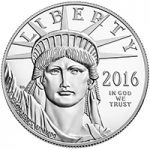
How Proof Coins are Made
Proof coins are a special type of coin made by the United States Mint. A newly minted proof coin is an uncirculated coin that has
Leaving a coin collection to loved ones can be a touchy subject. Like anything, it’s better to make a PLAN and decide what YOU want to have happen.
You may also consider it a battle. It’s a battle that you can’t be present for. Therefore, the plan is of utmost importance.
Here is a quote from a famous general:
“Every Battle Is Won Before It Is Ever Fought.
In order to set the stage for victory, you need to manage both your resources and your forces wisely. Preparation matters: Every battle is won before it is ever fought.” ~ General Sun Tzu
So what do YOU want to have happen with YOUR collection?
I can be sure what you DON’T want to have happen is that your collection is left to someone who doesn’t know the value of the coins and then sells them for whatever they can get because they just don’t know any better. You’ve spent years building up your collection, labeling it, rooting for the best deals, storing them and then they are sold for a fraction of what they are worth to a pawn shop or the like.
To be fair, if they don’t know anything about the coin collecting hobby, they won’t know what’s valuable and what isn’t. For example, let’s say you leave a loved one some silver eagles. They don’t know about the history of silver eagles. They don’t know the coin words connected to silver eagles. They don’t know what they are worth. So, they see it’s a “bullion” coin and that each one is one ounce of silver. You have 10 of them which, in their mind, is worth ten ounces of silver. Okay, they go to a website that shows silver value, like kitco.com, and see one ounce of silver is going for $15.00 per ounce. They sell your ten silver eagles for $150.00 and think they’ve gotten a decent deal. They don’t realize they’ve just sold them for less than they should have. Or, maybe you managed to get a high grade 2019 reverse proof silver eagle which could be worth over a thousand. If they sell it for the bullion price, they just threw away hundreds of dollars or more. If they researched the value on the U.S. Mint site, they would see that they were selling for $65.95. Again, they would potentially lose hundreds if they sold it for that price.
You can’t expect non-coin collectors to know the words and the ways of coin collectors. You have to help them out by being as organized as possible.
Simple training can go a long way. When you are giving coins to someone, or giving instructions to someone on how to distribute your coin collection, make sure they understand the following basic coin words. I’ve included some pictures to make the words easier to grasp.
A small piece of metal, usually flat and circular, authorized by a government for use as money.
The study and collecting of coins, money and tokens.
The different values of money. For example, quarters, dimes and nickels are all different denominations.
The value that is shown on the coin.
The amount that an item can be sold for. For example, a cent from 1890 says, “One Cent” on it. That would be the face value. These days, you could sell that cent for several dollars or more. That’s the resale value.
A small letter on a coin identifying which of the United States Mint’s facilities struck the coin
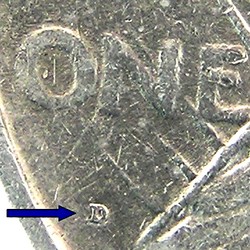
Photo by WikiMedia
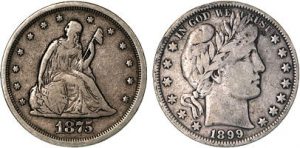 Circulate means to pass coins or money around as payment for goods or services. Thus a coin which has ever been used in this manner is a circulated coin.
Circulate means to pass coins or money around as payment for goods or services. Thus a coin which has ever been used in this manner is a circulated coin.
 Refers to a coin which has never been used as money in everyday financial transactions.
Refers to a coin which has never been used as money in everyday financial transactions.
Rating which indicates how much a coin has worn from circulation
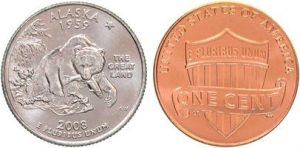 Refers to a coin which has not been circulated and which still retains the majority of its original mint luster.
Refers to a coin which has not been circulated and which still retains the majority of its original mint luster.
 Refers to a coin which has been made using highly polished dies and with great care. Proof coins are not intended for circulation but are instead meant specifically for the collector to serve as pristine examples of the coins made for the year.
Refers to a coin which has been made using highly polished dies and with great care. Proof coins are not intended for circulation but are instead meant specifically for the collector to serve as pristine examples of the coins made for the year.
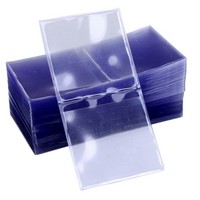 A 2 x 2 clear plastic sleeve, safe for storing coins in (you should get the ones that say “Non-PVC”).
A 2 x 2 clear plastic sleeve, safe for storing coins in (you should get the ones that say “Non-PVC”).
 A 2”x2” carboard with a hole roughly the size of a particular coin. The cardboard folds over the coin, keeping it in place but still displays both sides of the coin.
A 2”x2” carboard with a hole roughly the size of a particular coin. The cardboard folds over the coin, keeping it in place but still displays both sides of the coin.
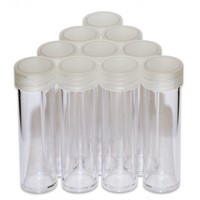 A clear plastic tube for coins.
A clear plastic tube for coins.

Nickname for some protective coin encapsulation methods, especially those that are permanently sealed and rectangular.
Make sure these basic terms are understood by anyone you are leaving your collection to, or anyone who will be responsible for it.
Remember, when we speak of “grade” we are referring mostly to the wear and tear on the coin. There are other factors too. There is a whole profession built around the activity of grading coins.
We have written other articles on the subject. But for simplicity’s sake, we present to you here a tool you can use to help in grading your coins. This is from the Professional Coin Grading Service and it is called their “PCGS Photograde™ Online”. In this, you can look up the coin you are interested in and see photos of it in different grades.
The grade of the coin affects its value.
Bear in mind that not everyone will agree on the grading of a coin. Don’t be shocked if you see a discrepancy in grading between different professional coin graders.
For a fee, you can send your coins to a professional coin grading service. PCGS, for example, will grade your coin and put it in a slab for you. They will put all of the grade information on the slab as well as give it a unique number. They will register their coin in their registry. This activity makes future sales of those coins easier. Bear in mind, it wouldn’t be cost effective for all of your coins. If the cost of the grading fee is more than the value of the coin, you’ve just lost money.
Don’t touch the face of the coins. Only pick them by their sides.
Don’t clean the coins or you might reduce their resale value.
Don’t scratch the slab. If the coin is in a slab, keep the slab nice.
Store them in a cool, dry place. Mildew and corrosion don’t enhance the value of coins.
This is probably the most crucial part of the plan. A detailed inventory of the coins you have will allow any other work that has to be done to take place. The best time to fill this out would be when you purchase the coin. You could put it in a spreadsheet. Or, if you’re not a computer person, you could write it out by hand.
Include in your inventory all of the following information:
Your inventory could look similar to this.

Ascribing value can only be done by diligent homework.
The value of coins can change over time.
If you want to leave the coins to loved ones based on their current retail value, you will have update the prices before they can be divvied up.
One method is to look to see what the coins are currently selling for. You can check eBay for recent sales. You could check the RED BOOK by R.S. Yeoman, which gives coin values. Coin magazines also give values and other interesting information. Get a realistic value of what the coin is currently selling for by consulting several references.
Another method is to look up the value of the coin on the Professional Coin Grading Service (PCGS) Coin Price Guide. Click here for more info.
If you are selling to a re-seller, like a coin shop, he has to purchase for a price which will allow for a profit. And he has to pay his staff, pay to package the coin, pay to ship the coin, etc. He has to offer a price which is lower that what he can sell it for or he’ll go broke. On the positive side, he’s more likely to buy up the entire collection, or a good deal of it. If you are selling to private collectors, you have to pay for all the costs associated with selling it. Even though you are getting a lower price than you might like from the re-seller, you’re doing a LESS work. (For an example of what it can be like going to a coin dealer, see the YouTube video SELLING YOUR COLLECTION in the References section.)
Some coins just aren’t worth very much despite what people may think. Do your homework thoroughly before you accidentally leave a mess for your loved ones. For example, the U.S. Mint made billions of wheat pennies. Yes, some of them can be worth a great deal of money. But for the most part, most of them are worth two to three cents to a dealer. Some feel they have a treasure trove of coins only to find it would be better to just take them to the nearest coin cashing machine and dump them in. If that’s the case, it’s better to find out BEFORE leaving them to another to sort out. Better to take those to a coin cashing machine and save someone else the bother of taking them out of all of the wrappers, tubes etc. If they aren’t a coin collector and it’s purely a matter of resale value, just give them the cash.
I’ve spoken a great deal about monetary value of coin. Let’s also consider the personal value of a collection. Coins are valuable if you like them. I have couple circulated 2019 shield cents with interesting toning. They are both worth exactly one cent. But they are more valuable than that to me just because I like them. If the person you are planning on leaving them to is a coin collector, they might like them for the same reason. I call that to your attention just because coin collecting shouldn’t only be about their resale value. Remember, coin collecting is a hobby.
Counterfeit coins are prevalent. There are various ways of detecting these. The weight will usually be off. The counterfeiter will use less valuable metals to make the coin and the weight will almost certainly never be the same. Your homework will have to include researching your coins to make sure there are no counterfeits.
Copies of coins aren’t illegal if they say COPY on them. You shouldn’t expect them to be worth much.
Again, I call to your attention, ascribing value to coins can only be done by diligent homework.
The simplest thing to do would be to put together an inventory, decide who you want to have the coins and just give them to them before the time you depart. If you can, give it enough time before passing that there won’t be squabbles. Along with the coins, give them an inventory of what they are receiving and some simple training on what these things are and what they are worth. Teach them the basic terms of numismatics, or give them some simple materials. Then, they will have some knowledge of what they are doing and are less likely to make an error. They can decide if they want to continue the hobby, or sell their coins.
“Education is the key to enjoying your hobby more.” ~ Rod Gillis
Perhaps you feel most comfortable leaving the collection in a will and allowing an executor to administer your coin collection. Even so, your diligent homework will make their duties easier. Your wishes are at risk of not being carried out if you don’t also give your executor a detailed inventory and some education. Lawyers aren’t numismatists. They might turn in your silver eagles for a dollar each if they don’t know what a silver eagle is and there is no inventory ascribing value. (Bear in mind, a silver eagles says $1.00 right on it.)
Make your plan considering the above information. Consider how YOU want YOUR collection to be handled. If it gets too complicated and you want to put it aside, you should simplify your plan. The plan is the thing.
In the prosperous, vital, essential, vivacious, alive-and-kicking meantime, put more treasure in your treasure box!

Proof coins are a special type of coin made by the United States Mint. A newly minted proof coin is an uncirculated coin that has
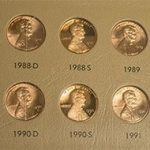
This is Part 2 of our series on Coin Storage. If you have not read Coin Storage Part 1 you can read it here. One of the most
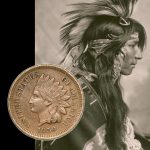
Who is that woman on the Indian Head Cent?! The Indian Head Cent was created by the artist James B. Longacre. In 1858 the pattern
The easiest way to get in contact with us is by filling out the form and submitting it.
We will contact you as soon as we can.
David Enders
PO Box 508
Athens MI 49011
The Dave’s Collectible Coins customer service goal is simple:
We are committed to providing our customers total satisfaction. Every time. Guaranteed.
For non-urgent matters please use the form in this popup. For urgent matters please call 269-742-4716.
Customer service is available Monday – Friday 8:00am – 4:30pm EST